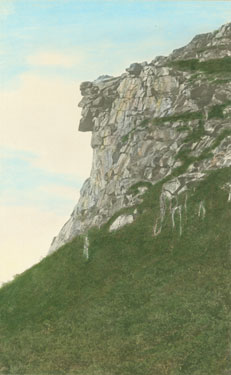13. The Old Man of the Mountain
Located: 1st floor hallway, near Courtroom B
Print in courthouse exhibit: Charles Henry Sawyer’s color-tinted photograph of the Great Stone Face of Cannon Mountain (New Hampshire Historical Society)
While this treasured natural monument was finally lost to the ravaging effects of centuries of extreme weather in May, 2003, the Old Man of the Mountain will forever be memorialized by the work of photographers and craftsmen. At the turn of the 20th century, Charles Sawyer was one of few early pioneers in the art of hand-colored and painted photography, which became popular in the decades preceding the invention of color film. In 1919, he opened his Concord studio at this very address, 55 Pleasant Street, where he maintained a staff of up to thirteen painter-colorists who diligently employed Sawyer’s hand-coloring techniques under his close supervision.

Essays
The Old Man of the Mountain
The well-known and loved Great Stone Face of Franconia Notch was carved by a retreating glacier more than 12,000 years ago. Five separate layers of Conway granite deftly balanced one on top of another, protruding with a convincing, chiseled gaze over Profile Lake. The Old Man’s visage was endearingly human: His mouth was slightly open as if to enjoy the clear, cold New Hampshire air; his eyes calmly fixed on the horizon. This sculpture by nature had the perfect proportions of a wise old gentleman’s face. A thick dash of graying hair sweeping the forehead hinted at youth gone by. The nose and chin were angled in symmetry, with just enough irregularity to prove he was real.
Indeed, there was nothing artificial about the Old Man! This rock formation, so magnificent to look at, so significant to the State of New Hampshire, was a real and especially poignant example of the power of nature to create awe-inspiring wonders and phenomena. As the Old Man gazed easterly from his perch high above the cliffs of Franconia Notch, he served as a natural guardian over the vast White Mountain Forest.
New Hampshire natives and tourists alike had read and heard that the Old Man was weakening. Geologists had been concerned about him for a hundred years. They warned that his stability depended solely on the fortunate orientation of the center of gravity just under his chin. Above that spot, the five slabs of rock (forty feet, five inches in height and twenty-five feet wide) were precariously balanced.
As the enormous formation endured the rain, snow, ice and wind of the mountains, experts installed and maintained cables, attempting to preserve the Great Stone Face. Despite all attempts, however, the distinguished profile could not be saved. Centuries of the ravaging effects of extreme weather finally brought the Old Man of the Mountain down, sometime in the middle of the night on May 3, 2003. No one was present to witness the collapse.
The people of New Hampshire were dismayed and heartbroken at the loss of this treasured natural monument. As a celebrated part of the state’s history, the Old Man of the Mountain will not be forgotten.
An historic, color-tinted photograph by Charles H. Sawyer (c.1915) is on display on the first floor of the US District Court building.
About the Photographer
This hand-painted photograph of the Old Man of the Mountain, taken circa 1915 and digitally reproduced for this display, was the creation of Charles H. Sawyer (1868-1954).
Charles Sawyer worked briefly for the famed Wallace Nutting, who was a pioneer in the field of hand-colored and painted photography. In 1904, at his first studio in Farmington, Maine, Charles Sawyer began applying watercolor paints to his own black and white photographs. The process of hand-coloring resulted in a translucent color over an entire photograph, while hand-painting would cover and sometimes alter details within a picture. Oil paints were later introduced to his processes. In the days of purely black and white photography, hand-colored and painted works were in high demand, and Charles Sawyer enjoyed commercial success.
In 1919, Charles Sawyer moved to Concord, New Hampshire, opening his photography studio at this very address, 55 Pleasant Street. This new location gave him easy access to the scenery of the White Mountains, which were a main focus of his photography. By 1925, Sawyer employed a staff of up to thirteen painter-colorists who enhanced his photographic prints one at a time, according to his direction.
Charles Sawyer’s son, Harold Sawyer, accompanied his father throughout New England, New York State, the western national parks, the Pacific coast and the Canadian Rockies, producing a great variety of scenic photographs. Charles Sawyer garnered a national reputation and sold his works through retailers across the United States, although the vast majority of his photographic subjects and sales were based in New Hampshire.
Hand-painted photographs are a unique art form from the early twentieth century, predating color film photography. By the 1940’s, however, the popularity of hand-colored and painted photography had seen its peak. Charles Sawyer prints are now a prime subject for collectors.
The Sawyer Picture Company operated continuously at this address until 1954, the year of Charles Sawyer’s death. The construction of a federal building on this site in 1965 required Harold Sawyer to move the business to another location in Concord, where it remained in operation until 1980.

Great Stone Face of Cannon Mountain - (Sawyer, c. 1915.)



